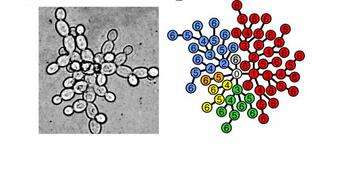Geometry, programmed death might have enabled evolution of multicellularity

Geometry and programmed cell death may have helped along the evolution of multicellular life, according to new research led by SFI Omidyar Fellow Eric Libby.
Writing in the journal PLOS Computational Biology, Libby and colleagues argue that genetically-programmed cell death likely evolved along with multicellularity, laying the foundations for the reproduction of multicellular organisms.
The team took inspiration for their results from a recent experiment on yeast. In that study, researchers repeatedly grew the yeast Saccharomyces cerevisiae in test tubes and selected whatever sank to the bottom for more growth. Because the yeast cells that stuck together tended to sink, larger clusters survived this artificial selection.
So too did rudimentary reproduction: when one cluster got too big, it would simply break apart, forming two distinct organisms. But a more counterintuitive trait evolved as well—individual cells that were programmed to die sooner than their unicellular ancestors.
One reason, Libby says, is space. In the multicellular yeast creatures, each cell can split in two, forming new branches along which the organism grows. But if the multicellular organisms grow too large, they'll start to compete with each other for nutrients and eventually crowd each other out. Unabated, that trend would limit the success of the new species. With cells born to die quickly, however, an organism can avoid that fate. Rather than suffocate itself, cells die, breaking one creature into two more manageably-sized ones.
Still, why death? Isn't there some other way for the yeast creatures to break apart?
Other mechanisms might be "just as beneficial, but since death is a natural part of most organisms, it is wise to co-opt it in such a way to benefit the living," Libby says. "We must view the group organism as a completely new environment, one in which traits like cell death might have different consequences" for the health of living things.
More information: PLOS Computational Biology (September 18, 2014): www.ploscompbiol.org/article/i … journal.pcbi.1003803
Journal information: PLoS Computational Biology
Provided by Santa Fe Institute

















